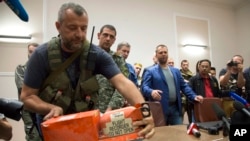As the Dutch paid their respects Wednesday to victims of the Malaysian airliner shot down over eastern Ukraine, an international team of investigators is examining the Boeing 777-200’s voice and flight recorders for clues about its demise.
Investigators say the voice recorder retrieved from the crash scene has been damaged but shows no evidence of manipulation, the Associated Press and other media reported.
It had taken several days of negotiations before pro-Russian rebel leaders controlling the crash site near Donetsk had handed over the two “black boxes.” The voice and flight recorders tracked the final minutes before Malaysia Airlines Flight 17 was shot down, killing all 298 people aboard. Nearly half of the passengers were from the Netherlands.
Watch: Related video by VOA's Carolyn Presutti
The delay, along with U.S. accusations that the rebels had deleted social media posts boasting they’d downed an aircraft at approximately the same time and place at which Flight 17 exploded, have fueled suspicions of tampering. The rebels have proclaimed their innocence, instead saying the flight was shot down by Ukrainian government forces.
Investigators found the voice recorder “was damaged but not manipulated, and its recordings were still intact,” the Dutch Safety Board said in a statement, according to the Associated Press.
“Black boxes are designed to withstand tremendous force, but all of the data from the boxes are stored on memory chip,” says Anthony Brickhouse, who teaches a course on aircraft accident investigation at Embry-Riddle Aeronautical University in Daytona Beach, Florida. “… Once you take the memory chip out, then it’s exposed. Conceptually, you could destroy” the information.
But “a trained investigator would be able to look at the unit and know it had been tampered with,” Brickhouse added.
What is a black box?
“Black box,” a misnomer, refers to the two recording devices required on commercial aircraft: a cockpit voice recorder and a flight data recorder. Each comes sheathed in bright orange metal casing to enhance visibility. They can be completely separate devices or they can be housed in a single chassis.
A cockpit voice recorder tracks all sound in the cockpit, from conversation to ambient noise such as buttons being pushed or doors opening. “It will tell you what the crew was doing, right up until the time something untoward occurred,” said Les Dorr, a Federal Aviation Administration spokesman.
“A flight data recorder will tell you what conditions the aircraft is experiencing and what the aircraft systems are doing at any given time,” Dorr said.
It can track air pressure, turbulence, wing adjustments, altitude and much more.
The Boeing 777-200 downed in eastern Ukraine was equipped with 20-year-old recorders, said Steven Brecken, spokesman for Honeywell Aerospace. The New Jersey-based firm had acquired the company that made the airliner’s first-generation solid-state recorders.
Its cockpit voice recorder had a capacity of 30 minutes, unlike newer models that go up to two hours before an incident halts its operation.
The airliner's flight recorder can track up to 25 hours. An airline and the government that oversees it determine what will be measured, Brecken said. “It’s proprietary information, not provided to Honeywell.”
NTSB investigator to assist
The U.S. National Transportation and Safety Board was sending a senior investigator to assist in downloading flight and voice data. Investigators will examine the flight data on Thursday, the AP reported.
The NTSB declined an interview request, instead providing a video clip of research and engineering director Joe Kolly explaining and demonstrating how black boxes work.
The recording devices -- layered with aluminum and insulation and corrosion-resistant stainless steel or titanium – are built to withstand extreme conditions, according to Honeywell. The devices can retain data for up to two years, surviving impact of up to 3,400 Gs, ice, or fire of up to 1,100 degrees Celsius for an hour.









